what should i use to cover strawberries for the winter other than straw
Straw mulch vs. hay mulch: In the battle to control weeds, add fertility, and better the water retention of your soil, is one really meliorate than the other? Well, in a word . . . yes!
Straw Mulch vs. Hay Mulch: What's the Difference?
Let's kickoff at the beginning. What is the deviation between harbinger and hay? Or are they essentially the aforementioned affair?
Many people recall they're identical because they're both often tied into square or rectangular bales, but a closer look reveals that they're actually quite dissimilar. Understanding these differences may assistance in your decision about which textile better suits your gardening needs.
Characteristics of Straw
Straw is the stalk of a cereal ingather such as oats, barley, wheat, or rye after harvesting has removed the seed heads.
Unremarkably a big machine called a combine harvester will come along into the field. In i smooth operation, it chops off the top portion containing the grain and sends the grain in i direction for processing, and and so cuts the harbinger and collects it until a bale-sized block is formed.
The harbinger bale is automatically tied and is then dropped out of the car, back onto the field for later collection.
Yous May As well Enjoy:
"How to Make Fish Emulsion Fertilizer"
"A Simple Fertilizer From the Greek Gods" (Fertilize with Beer and Milk)"
"Bound-Offset Your Compost With These 5 Free, DIY Compost Activators"
In many parts of the world, straw is seen as a waste product—a secondary past-production of the cereal crop—and is sold for practically nada.
But where I alive in Nova Scotia, Canada, it is actually more expensive to buy straw than it is to buy hay, because non much straw is produced locally. What straw nosotros have is speedily purchased for brute bedding. We but don't have the climate for mass cereal crop production.
Characteristics of Hay
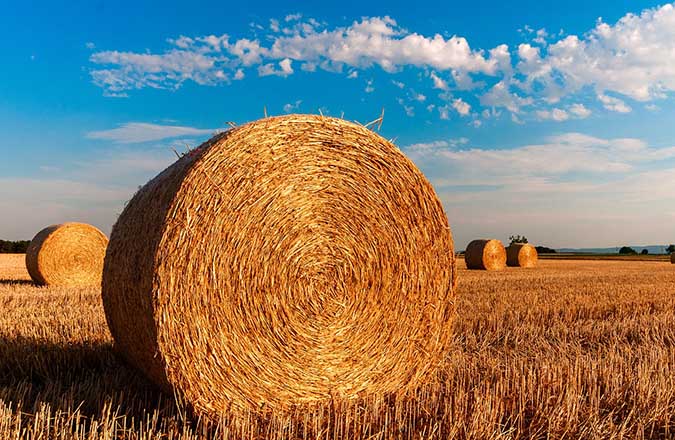
Hay refers to grass that has been cut while green, dried, and and then made into square or round bales. Hay is used mainly for feeding animals when no fresh grass is bachelor. It provides bulk, fiber, sugar, and nutrients to creature diets.
The best hay smells sweet, and if yous have a scattering and get it moisture, it all the same looks like grass. (Straw has an nearly exclusively yellow color when information technology is baled, and just a hint of a smell.)
Hay bales can expect like a greenish coarse grass, fine grass, or even flowery and weedy grass; it entirely depends on what plants were cut and stale to make the bales. The quality can vary hugely depending on the skill of the farmer making the bales and the quality of his hay fields.
Information technology is very important to get hay that has been dried to the optimum level, and then that it's not crumbly only is dry out plenty to discourage mold growth. Overly stale hay starts to compost quickly when it is damp, and composting hay bales have been known to oestrus up and commencement barn fires.
Straw Mulch vs. Hay Mulch
And then now that you lot know the divergence between straw and hay . . . why would you choose 1 over the other for mulching your garden? I mean, it'due south merely mulch, right?
The benefits of mulch in a garden cannot exist overstated and, if you're reading this article, I assume you already know how terrific it is for controlling weeds and providing walkways.
A adept mulch also helps the soil to remain cool and moist longer in summertime and tin insulate the soil in colder conditions. Mulch creates a microclimate over your soil by substantially interim as a blanket to protect information technology from the harsh drying effects of the sun and current of air.
All mulches perform this activity, including our harbinger and hay—but did you know that other mulches used around the world have included wood chips , bark , pine needles , shredded leaves, and even rocks ?
Yes, rocks.
The inhabitants of Easter Isle recognized that mulching prevented the wind and rain from eroding the valuable topsoil, and so they used volcanic rocks spaced out on their fields as a lithic mulch to boring runoff and current of air erosion. (Simply I tin can't imagine nearly of us deliberately placing rocks in the garden, can you? I know that in my ain garden, I'1000 constantly doing the reverse, because every year my garden seems to grow a new supply of rocks.)
You May Besides Enjoy:
"Sheet Mulching: Build Soil, Thwart Weeds, and Make Your Garden Fertile"
"Grow a High-Performance Garden, Episode 10: 'Mulching Fourth dimension!'"
"7 Keys to Good Water Management in the Organic Garden"
Surely some of these mulching methods work meliorate than others, wouldn't you think? Do some piece of work better in areas of wind or rain? Are some better suited for slopes? What about availability? These are all questions you lot need to respond for yourself. Then, experiment to see what actually works for y'all.
Planning is a huge function of having a successful and productive garden over the long term. You lot should choose the location wisely, taking into account the sunlight, blazon of soil, and climate.
Simply, in reality, well-nigh of u.s. just have to use any nosotros've got. Not everyone has 20 acres and can selection the perfect spot. So, let's just say that you are growing in a typical dwelling garden and the mulches you tin can most easily and economically get are hay and straw.
Harbinger Mulch
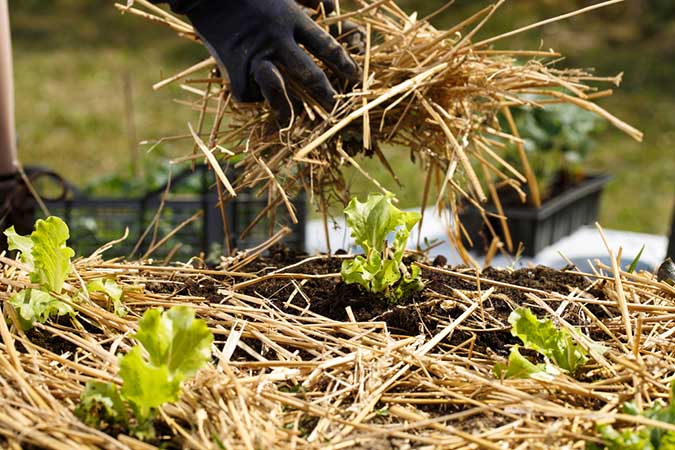
Straw mulch in garden beds
The Pros of Using Straw Mulch
Straw is a terrific insulator. The hollow stems retain air and their chopped, light, fluffy texture allows for piece of cake spreading. In fact, the principal uses for straw in the U.S. over the by 200 years take been equally fauna bedding, for insulating walls in homes (or edifice straw bale houses), and for covering the ice in ice houses to act as insulation so that the water ice is available for utilise during the summer.
You May Likewise Enjoy:
"How to Sail Mulch for an Abundant Garden"
"Garden Slugs? iii Easy Ways to Kill Them WITHOUT Toxicant"
"Overheated Ducks? No Problem!"
When used in a garden, it also tends to remain lighter and fluffier than hay, and it keeps a beautiful gilded appearance for quite a long time.
The surface remains dry even as the everyman layers touching the soil brainstorm to decompose. Have you ever picked strawberries in a field? Almost certainly there was harbinger around the bushes and information technology gave you a good clean place to sit or kneel that felt soft and cushioned.
The Cons of Using Straw Mulch
Straw tin be expensive depending on where you live, and yous might not be able to grow it yourself. Straw tin as well human action as a dwelling to rodents considering of its fluffy texture. It has a higher trend to accident abroad in strong winds when information technology is commencement laid, unless you try very hard to pack it downwardly.
Straw does add some majority to your soil, but it is generally equanimous of cellulose and fiber that are left over after the establish puts all its nutrients into the seed heads that were harvested for grain. Consequently, straw adds fewer nutrients back into the soil when it decomposes, and soilborne leaner tie up the available nitrogen for a longer fourth dimension to break down the tougher stalks.
You May Too Enjoy:
"35+ Powerful, Inexpensive Organic Fertilizers Y'all Can DIY"
"Homemade Fertilizers—15 Simple and Inexpensive Options"
"Aerobic Compost Tea, Worm Tea, and Leachate—A Clarification"
Because straw is fluffier and makes less directly contact with the soil, information technology takes longer to decompose . . . which is both a plus and a minus. If you want to add nutrients, this is a minus, merely if maintaining a cover or walkway is of import, then it's a plus.
Diddled-in weeds won't land in a moist environment and sprout but, on the other hand, in-ground weeds are more than easily able to push through a harbinger mulch from the bottom due to its fluffy nature. You tin can counteract this result past weeding, putting downwards some paper before laying the straw mulch, and using a thicker layer—perchance 8 inches thick or more—to provide a darker environment that well-nigh weeds only don't have the energy to get through.
Hay Mulch
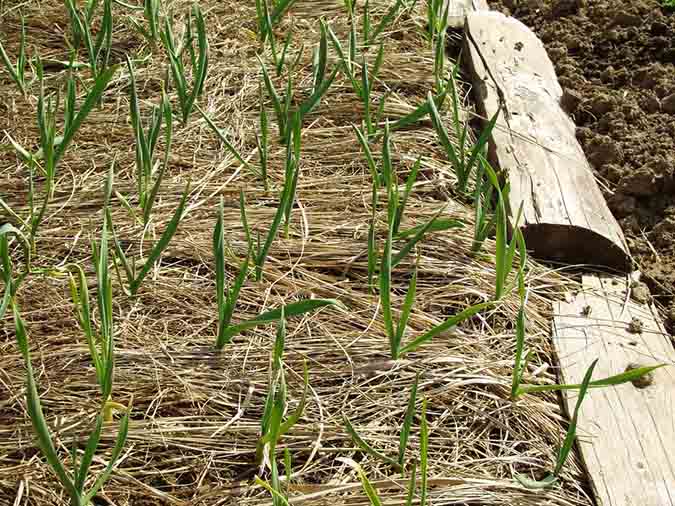
Hay mulch, with winter garlic sprouts growing through
The Pros of Using Hay Mulch
Hay is readily available and it's possible to get a scythe and cut your ain if you take a grassy expanse on your property. You don't need to bale information technology—just cut it, permit it dry out, and then fork it into your wheelbarrow and cycle information technology over to where it's needed. Even long grass clippings can function the same fashion as hay, considering they're essentially the same thing.
Learn how to create the vibrant soil you've always wanted with our sectional Compost and Soil Fertility Toolkit —featuring 32 expert-led trainings that embrace everything from compost and soil detox to worm farming and the Mittleider Method. Click Hither to >>Name Your Price<< for the Compost and Soil Fertility Toolkit!
Hay left over from a previous year is often considered garbage past farmers who desire to feed their animals the virtually recent and more nutritious hay. Consequently, hay is sometimes available for free during hay season in the summertime.
You May As well Enjoy:
"five Inexpensive, Simple Solutions For Small-Space Composting"
"6 Organic Nitrogen Fertilizers for Healthier Soil"
"Brand Peace With Your Poop (and And so Brand Compost With It!)"
Yous can find it past looking at your local online ad site, such as kijiji or craigslist, or by asking your farming friends.
Hay contains a variety of grasses and legumes, plus often clover and other flowers (including both the leaf and stalk), then the institute nutrients are all there.
When hay decomposes, information technology adds pregnant nutrients to the soil to increase its fertility. It adds a balanced ratio of NPK, as well as all the trace minerals that were independent in the plant.
Hay tends to lay flat and pack down, so it decomposes fairly quickly.
It also has more of a sponge effect than straw does, which means that in heavy rainfalls, information technology buffers or slows down the amount of rain that soaks into the soil to help prevent erosion and leeching of nutrients.
Because hay packs down densely, the weeds from underneath get smothered and die very apace. But weed seeds that blow in can sometimes sprout, peculiarly in an older hay mulch that is very damp.
The Cons of Using Hay Mulch
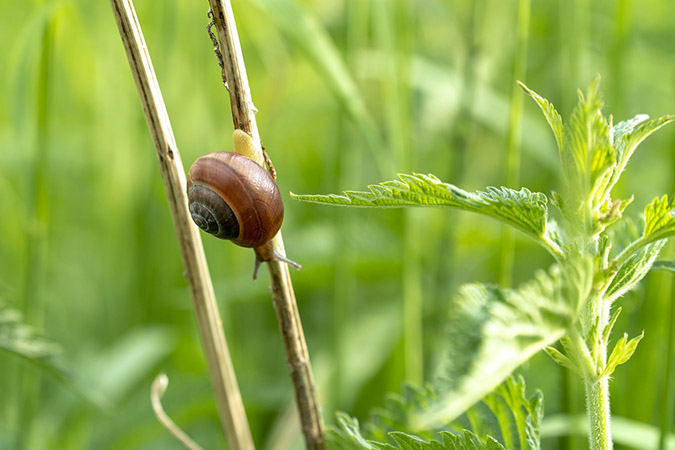
Hay mulch has a trend to attract snails and slugs in rainier climates.
In moist parts of the earth, hay mulch has more of a tendency to harbor slugs and snails, and so you need to continue a proficient middle out for them and have a method of removal set up.
Hay generally doesn't harbor mice, because information technology'south also dumbo. Hay takes on a packed and spongy texture that holds water, so sitting afterwards wet atmospheric condition is likely to exit you with a wet bum.
Hay holds wet, allowing seeds on top to sprout, which is why some consider hay bale gardening to be such a great thing. Merely if yous're trying to suppress weeds, do you really want this? And ofttimes the hay itself contains seeds that will sprout once they get wet, and then you lot could end upwards with a living pathway until the dry weather condition dries out the topmost layers of your mulch again.
You May Also Bask:
"Straw Bale Gardening: How to Succeed"
"Lasagna Gardening Builds AMAZING Soil!"
"The Hidden Dangers of Harbinger Bale Gardening"
Every bit hay decomposes, it is cleaved downwardly by various bacteria and other organisms that all utilize nitrogen, just as we discussed for the decomposition of straw. So what happens is that these organisms get a new food source (your hay compost) and they multiply chop-chop, which depletes the soil of nitrogen. Equally they run out of nutrient, the organisms die and the nitrogen is once more bachelor for the plants to use.
Then planting direct into a hay mulch without whatsoever supplemental nitrogen source available probably isn't the best idea.
Which Should Y'all Choose?

Now that you know more than nigh hay and straw as mulches, which one are you lot going to choose?
The Perfect Solution
In a perfect world, the solution is to employ both—a thick layer of hay mulch on the lesser, where it volition decompose and act as a spongy reservoir for moisture, topped off with a few inches of straw that will be a dry layer, preventing blown-in weeds from sprouting and giving you a lovely, dry, gilded walkway.
What If Y'all Can Only Apply One?
But nosotros don't all live in a perfect globe, do we? We're but trying to brand the best of what nosotros've got, and that'due south what makes a great gardener or homesteader—the ability to problem-solve. And then, I'd suggest that if you have a choice of only i type of mulch, you use hay simply for the fertility it will add to your soil.
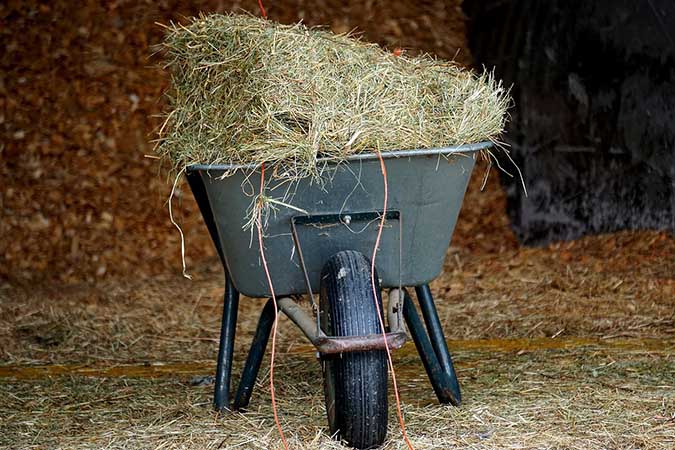
Use hay mulch instead of straw mulch if you can but choose one. If you can use both, do.
As all practical gardeners know, yous utilize what you take or tin hands go. Why pay money for straw if a local farmer will give you hay in July for nothing? If you can get it costless, but yous don't need it all at in one case, so simply put the extra bales out by your garden, throw a tarp over them, and salve them for next year.
If the hay gets wet and starts to compost itself, it really doesn't matter. It'southward all going in the soil in the end anyway, and the pile of bales tin can act as a windbreak while information technology waits to be used.
Your Evolving Garden
A garden is a living, breathing thing. It evolves from year to twelvemonth and, every bit gardeners, we are the stewards of the fertility that is in our soil.
It depends on us to pay attending and brand sure that we don't have out more than we put back in. After all, nosotros want our gardens to feed u.s.a. for many years to come up and to be places where we tin can teach our children and grandchildren the mysteries of growing their own food, too.
You May Likewise Enjoy:
"Special Challenges to Managing NPK in the Organic Garden"
"Compost Tea: An Easy Style to Stretch Your Compost"
"19 Uses for Spent Java Grounds in Your Habitation and Garden"
Gardens are places where families and communities come up together to work, talk, and visit, and then nosotros should try to make sure that, in addition to didactics the value of work, we also discover pleasure in being outdoors.
Planning the best method of mulching your garden is of import for fertility and moisture retention, and information technology will too significantly reduce the amount of time you spend watering and weeding, which volition in plough increase your enjoyment of your garden.
A well-mulched garden also makes amend use of the precious water resources that are becoming deficient in so many places. As a young man gardener, I encourage you lot to try new things and experiment with mulches to meet what works for you. Just most of all, have fun in the garden!
What Exercise You Think?
What is your favorite mulch to utilize in your garden, and why? Do yous take any other tips for getting mulching materials inexpensively or for gratuitous? Allow us know in the comments!
__________________
This is an updated version of an article that was originally published on July 20, 2015. The author may not currently be available to respond to comments, however we encourage our Customs members to chime in to share their experiences and answer questions!
The Abound Network is a participant in the Amazon Services LLC Associates Program, an chapter program designed to provide a means for our team to earn fees for recommending our favorite products! We may earn a small commission, at no boosted toll to y'all, should you buy an item later on clicking one of our links. Thanks for supporting TGN!
(Visited 58,062 times, 8 visits today)
gottschalktentons1991.blogspot.com
Source: https://thegrownetwork.com/straw-mulch-hay-mulch/
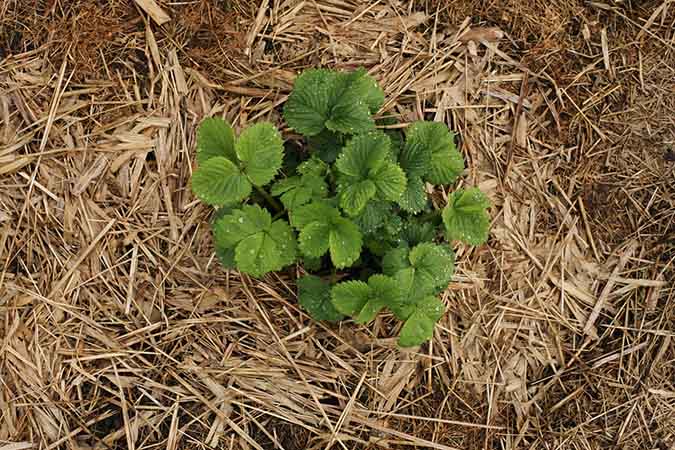
0 Response to "what should i use to cover strawberries for the winter other than straw"
Postar um comentário